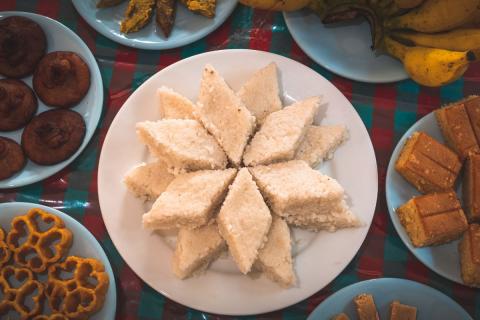Sinhala & Tamil New Year 2025 Customs, Traditions, and Timetable
Sinhala and Tamil new year rituals
The Sinhala and Tamil New Year, also known as 'Aluth Avurudu' in Sinhala and 'Puthandu' in Tamil, is one of the most significant cultural festivals in Sri Lanka. It marks the transition of the sun from the Pisces zodiac sign to Aries, signifying a new beginning. The festival is deeply rooted in astrological beliefs and features a series of rituals and customs performed at specific auspicious times. Here’s a breakdown of these traditions to help foreigners understand the celebration:
1. Bathing for the Old Year
Before the New Year officially begins, Sri Lankans take a ceremonial bath using a special herbal mixture. The herbs, including wood apple juice, are believed to cleanse the body and bring good health. During this time, people also reflect on the past year and prepare for new beginnings.
2. Dawn of the New Year
The New Year is welcomed at an exact astrological moment. Unlike the Western New Year, which begins at midnight, the Sinhala and Tamil New Year starts at a time determined by astrologers. At this moment, families stop their daily activities and focus on religious observances.
3. The Auspicious Time (Punya Kalaya)
This is a special period where all work comes to a halt. It is believed to be a neutral time between the old and new years. During this period, people engage in religious activities, such as visiting temples, making offerings, and performing prayers.
4. Preparing Festive Meals

One of the main traditions of the New Year is the preparation of special meals, including milk rice (kiribath) and various sweets. The process of cooking is done while dressed in auspicious colors and facing a specified direction, as per astrological recommendations. Milk is boiled in a new clay pot until it overflows, symbolizing prosperity and happiness.
5. Starting Work, Transactions, and Eating Together
After the neutral period ends, people resume their daily activities at the prescribed time. This includes starting work, engaging in financial transactions, and sharing meals with family and friends. The first transaction of the year is considered important, as it symbolizes prosperity and good fortune for the months ahead.
6. Applying Herbal Oil (Hisathel Gaema)
A significant part of the New Year customs is the oil anointing ceremony. A senior family member or a religious leader applies herbal oil to the heads of family members while reciting blessings for health and longevity. Special herbs such as neem and coconut oil are used for this ritual.
7. Leaving for Work and the First Journey
To ensure a prosperous year, people follow an astrologically determined time and direction when stepping out for work or travel after the New Year. Before leaving, they consume a traditional meal, symbolizing good fortune and success.
These customs are an integral part of the Sinhala and Tamil New Year, reflecting deep-rooted cultural and spiritual values. The festival is a time for family reunions, feasting, and celebrations, making it one of the most vibrant and joyous occasions in Sri Lanka. Whether you are a visitor or a resident, participating in these traditions is a wonderful way to experience Sri Lankan heritage and hospitality.
Sinhala and Tamil New Year Customs times 2025
Bathing for the Old Year (Parana Avurudda Sandaha Snanaya)
- Date: April 13, Sunday
- Ritual: Bathing with a herbal mixture containing wood apple juice.
- Significance: It symbolizes purification and a fresh start for the new year.
- Advice: It is customary to remember one's guardian deities while engaging in this ritual.
Dawn of the New Year (Aluth Avurudu Udawa)
- Date & Time: April 14, Monday at 3:21 AM
- Significance: The official transition from the old year to the new year.
- Customs: People prepare for festivities, engage in traditional games, and celebrate with family and friends.
Auspicious Time (Punya Kalaya)
- Duration: April 13, Sunday at 8:57 PM to April 14, Monday at 9:45 AM
- Customs:
- Ceasing all work and engaging in religious activities from 8:57 PM on April 13.
- Engaging in cooking, starting new tasks, and transactions between 3:21 AM and 9:45 AM on April 14.
Cooking (Ahara Pisima)
- Date & Time: April 14, Monday at 4:04 AM
- Attire & Direction: Wear copper-colored clothes and face south.
- Customs:
- Lighting the hearth.
- Preparing milk rice and traditional sweetmeats.
Starting Work, Transactions, and Eating (Weda Alleema, Ganu Denu Kirima ha Ahara Anubhavaya)
- Date & Time: April 14, Monday at 6:44 AM
- Attire & Direction: Wear pearl and white-colored clothes and face south.
- Customs:
- Resuming work and business transactions.
- Sharing meals with family and neighbors.
Applying Oil to the Head (Hisathel Gaema)
- Date & Time: April 16, Wednesday at 9:04 AM
- Attire & Direction: Wear green-colored clothes and face north.
- Customs:
- Applying herbal oil infused with neem leaves on the head.
- Bathing with a special mixture of neem leaf juice.
Departing for Work (Raki Raksha Sandaha Pitathwa Yaema)
- Date & Time: April 17, Thursday at 9:03 AM
- Attire & Direction: Wear golden-colored clothes and face north.
- Customs: Consuming milk rice and sweets mixed with cow's milk before leaving for work.
The time and dates here form :k.lakpura.com/
Significance of the Festival
The Sinhala and Tamil New Year is not only an astrological event but also a time of unity, joy, and renewal. Families come together to celebrate traditions, exchange gifts, and share meals. The festival strengthens social bonds and cultural heritage, making it a highly anticipated occasion for Sri Lankans worldwide.
These auspicious times and customs have been prepared with the assistance of astrologers from the Ministry of Public Administration, Home Affairs, Provincial Councils, and Local Government, ensuring their adherence to traditional beliefs.
Join the 2025 New Year Celebrations with Sri Lanka Tour Help!
Looking to experience the Sinhala & Tamil New Year in 2025? Let Sri Lanka Tour Help guide you through festive village experiences, temple visits, and authentic New Year celebrations! Plan your trip now at Sri Lanka Tour Help.



Comments
There are no comments yet